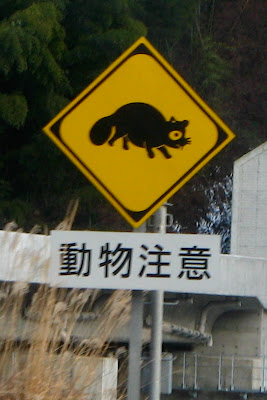Take Bayashi no Renshu
From blogurl:tazziedevil.wordpress.com - Google Blog Search by Duncan Stewart
httpv://www.youtube.com/watch?v=S1eX2FI1RuY…From blogurl:tazziedevil.wordpress.com - Google Blog Search by Duncan Stewart
httpv://www.youtube.com/watch?v=S1eX2FI1RuY…From Bujinkan Santa Monica by Bujinkan Santa Monica
 |
| photo by rumpleteaser |
A tanuki is a masked animal like a raccoon, yet big and stocky like a badger, and is known to fake being dead when surprised... because of this, the idiom "tanuki neiri" [literally "fall into a tanuki's sleep"] means to feign sleep.
Tanuki-neiri is said to have its origin in the days when no distinction was made between the tanuki and the mujina or badger, and the latter was believed to have been unable to see or hear during the daytime and therefore likely to just sit tight and try not to attract too much attention to itself.
Today the most common place to find people playing possum is in crowded commuter trains and subways, where younger people lucky enough to have found seats feign sleep to avoid making eye contact with elderly commuters to whom social convention dictates they give up their seat. Along with both its less common variations, tanuki and tanuki-ne, the idiom is not used as it`s English equivalent "play possum” to mean “feign ignorance."
Hatsumi Sensei says, that humans will show their true nature when around a "sleeping" person. He says, "If you pretend to be sleeping you can see to the bottom of the enemy's heart and intentions." And that, "you just cannot win if you do not have this skill of playing dumb."
Mats har blivit inbjuden av Bujinkan Haburamu Dojo i Istanbul att hålla ett träningsläger (för sjätte eller sjunde gången).
För mer information se Facebook event och Haburamu Dojos hemsida.…
Lägret blev en succé! Cirka 25 deltagare från Estland, Lettland och Litauen deltog under dessa två dagar. Temat för lägret var Sanshin no kata och Juttejutsu. Eventuellt blir det ett till läger i Riga efter sommaren.
Mats skrev en artikel om lägret, klicka här!
Se bilder från lägret här.…
From 8þ Kabutoshimen by admin
 I'd like to inform you about the most beautiful and best manufacturer of training weapons for Bujinkan (now also for Ko-ryu and Aikido) practitioners, PAART ( Petar Antunovic ART). Petar is a woodwork artist as you can see on the picture inserted.
I'd like to inform you about the most beautiful and best manufacturer of training weapons for Bujinkan (now also for Ko-ryu and Aikido) practitioners, PAART ( Petar Antunovic ART). Petar is a woodwork artist as you can see on the picture inserted.
I highly recommend these weapons. They are not only beautiful but also authentic.
 Den 15/1 hade vi ett “kick-off läger” och det blev en succé! Alla fem Shidōshi (instruktörer); Viktor, Kent, Daniel, Erik och Mats instruerade en timme var. Vi var ca 25 personer som tränade och hade kul under en hel dag. Förutom medlemmar från Kaigozan kom det också några från To Nan Dojo, Kasuga Dojo, Eskilstuna och Sundsvall. Speciellt tack till våra långväga gäster från Sundsvall
Den 15/1 hade vi ett “kick-off läger” och det blev en succé! Alla fem Shidōshi (instruktörer); Viktor, Kent, Daniel, Erik och Mats instruerade en timme var. Vi var ca 25 personer som tränade och hade kul under en hel dag. Förutom medlemmar från Kaigozan kom det också några från To Nan Dojo, Kasuga Dojo, Eskilstuna och Sundsvall. Speciellt tack till våra långväga gäster från Sundsvall ![]() .
.
Kanske det här kan bli början på en tradition, och att vi gör om det nästa år också?
Nedan är några bilder från dagen, för att se fler bilder klicka här.
From Uploads by YouTube Help by budoshop
…From Uploads by shugyou by shugyou
|
Kaigousuru 2 - the second International Bujinkan Training Party! with Arnaud Cousergue, Pedro Fleitas & Sveneric Bogsäter The theme was Kukishin-ryu and Kihon happo Get the VideoCD here... www.budoshop.se Or the Download version here... store.payloadz.com Happy training! |
From:
shugyou
Views:
369
     0
ratings | |
| Time: 00:45 | More in Sports |
From New Products from Budo Shop Store by New Products from Budo Shop Store
From Bujinkan Santa Monica by Bujinkan Santa Monica
 |
| photo by barto |
Momotaro's monkey excelled at wisdom, vicious wisdom. The pheasant had an ability to predict earthquakes. The dog looks faithful, but it can become like a ninja and smell the differences at work, using various means and tricks.Sensei goes on to say that to live well in troubled times we should practice these three elements and embody each animal with our body and soul.